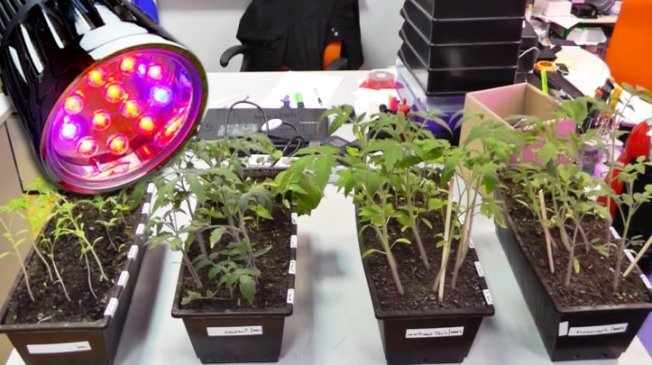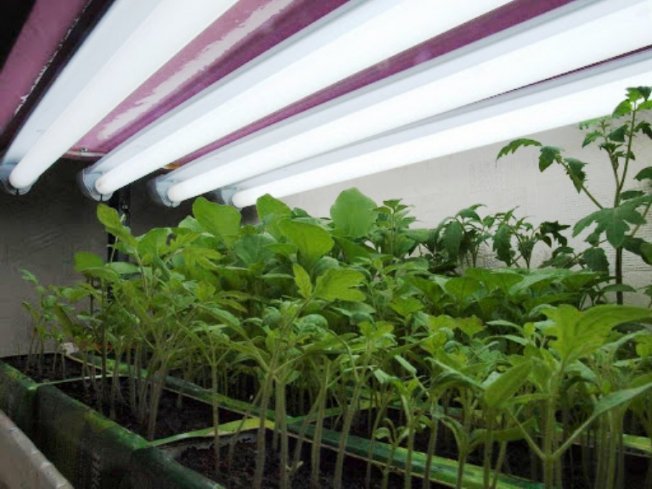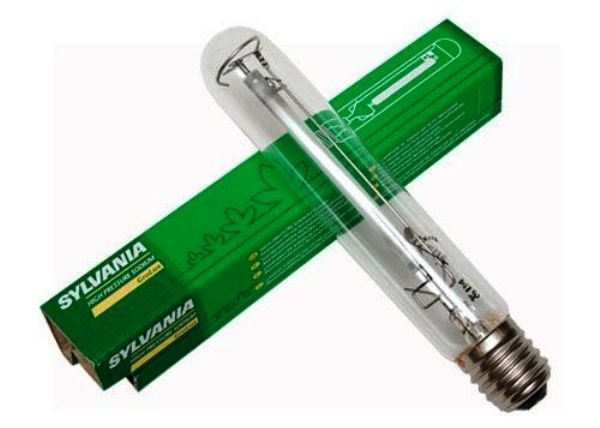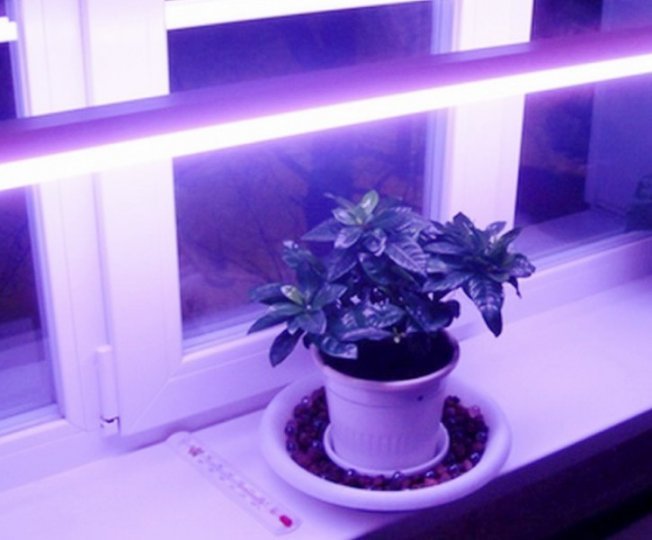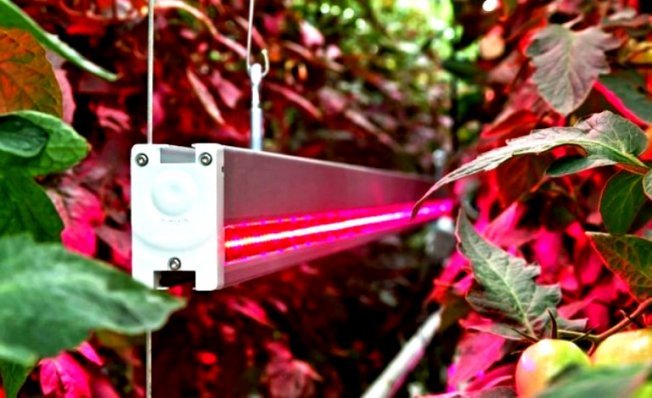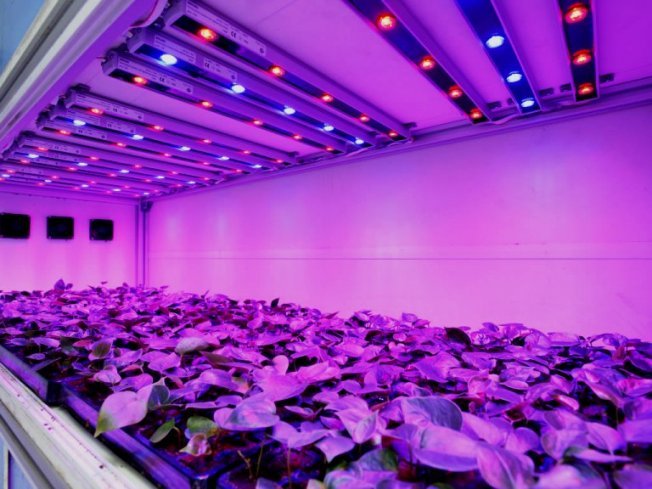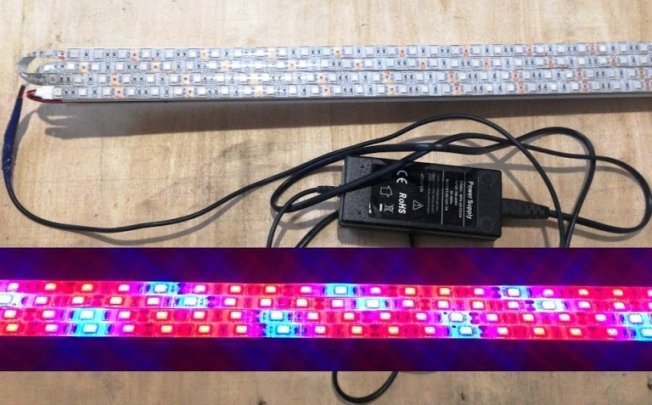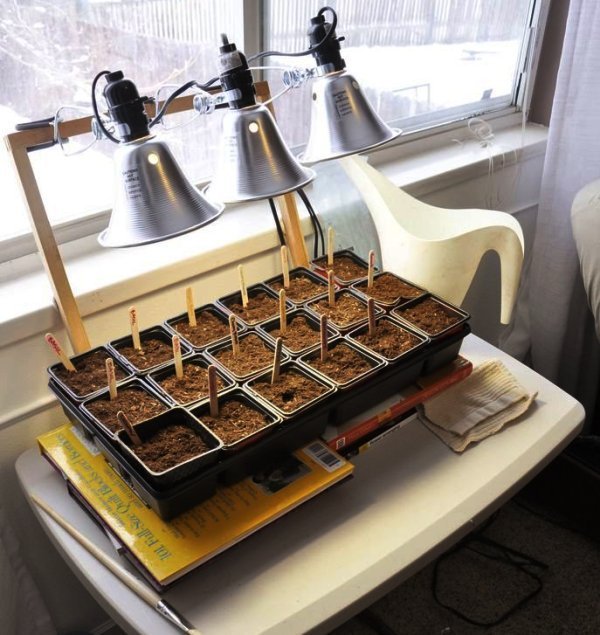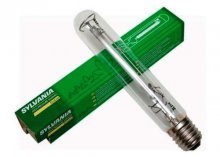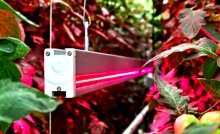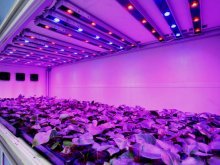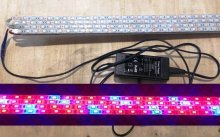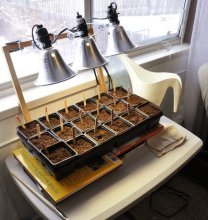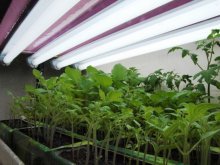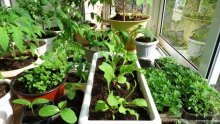Lamps for seedlings, their types, advantages and disadvantages, selection rules
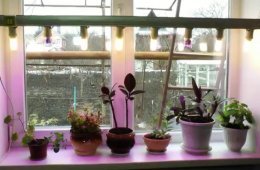
Lighting deficiency occurs when plants are grown during a period of daylight that does not meet the requirements. In this case, a seedling lamp and proper organization of lighting allow you to obtain healthy, strong seedlings.
Content:
- What kind of light do plants need?
- The influence of color on development
- Exposure to ultraviolet and infrared parts of the spectrum
- Types of lamps
- Sodium lamps
- Fluorescent backlight
- Benefits of phytolamps
- LEDs
- Homemade lighting from LED strips
- Rules for arranging lighting
What kind of light do plants need?
Vegetable crops, including tomatoes, sweet and bitter peppers, cabbage and cucumbers, and many annual flowers, are usually grown from seedlings. To obtain earlier flowering and fruiting, crops are sown in February or March, but daylight hours during this period are very short, and the weather is often cloudy for weeks. Naturally, the plants located in the room suffer from a lack of lighting. This has a detrimental effect on their general condition, they become pale and stretched out.
Seedling lamp helps to increase the duration of daylight hours, which affects the acceleration of the development process.
Optimal illumination is especially important for crops that have long growing seasons.
For normal plant development, you will need to select a device with certain parameters.Natural lighting is characterized by the presence of waves of different lengths, and if the human eye does not perceive the entire spectrum of solar radiation, then it is very important for plants to receive all its diversity.
Waves of a certain length have a directed effect and stimulate the development of the root system, stem, and leaves.
The influence of color on development
Usage lamps for illuminating seedlings accelerates the process of photosynthesis, creating a system of additional lighting should be taken into account: blue and cyan shades inhibit the growth of the stem, but stimulate the process of cell division, those. with not intensive growth, there is a noticeable thickening of the stems.
Red color stimulates growth; the predominance of this part of the spectrum when growing plants leads to the rapid development of the root system. Lighting with a red device accelerates the onset of flowering, fruit formation and ripening.
Orange works identically to red, but the intensity of its effect is slightly lower.
They have virtually no effect - green and yellow shades, rays containing this part of the spectrum, are almost completely reflected from the leaves. However, without their presence it is impossible to provide conditions for the full growth of pleasures.
Taking into account the above, we can conclude: when choosing a lamp, you need to think about whether you want to get strong plants with thick stems, to bring the beginning of flowering or fruiting closer.
The device should be placed at a certain height above containers with seedlings. The length of daylight for plants should be limited in time and should not exceed 15 hours.
Exposure to ultraviolet and infrared light
The spectrum of natural light consists of waves visible to the eye and those that are invisible to humans.Ultraviolet waves destroy harmful microorganisms, but you should not get too carried away with devices whose glow is dominated by ultraviolet rays; their excessive quantity also poses a danger to small plants.
Exposure to infrared light leads to acceleration of growth processes, active formation of fruits, and development of the root system. The process of vitamin accumulation is activated and leaf growth accelerates.
Additional illumination with lamps producing infrared radiation leads to a change in the temperature regime of the plants.
The human eye does not react to infrared radiation; we feel it as a thermal effect. At a temperature not exceeding + 20 C, infrared rays have a beneficial effect on seedlings, promote their growth, and accelerate the formation of new leaves. But at higher temperatures, infrared lamps can cause burns on the leaves, and due to the increase in temperature, the plant may wilt.
What types of lamps are used
When organizing lighting, it is recommended to take into account both the spectrum and the type of lighting sources. When choosing a type, you should carefully weigh all their positive aspects and take into account the negative aspects of their use. Note that not all lighting devices known to us are suitable for growing seedlings.
Popular options for illuminating seedlings are the use of devices:
- luminescent;
- phytoluminescent;
- sodium;
- LED
Depending on what goals are pursued by illuminating the seedlings, it is recommended to use the above types of lamps; the light emitted by them will allow you to grow strong, actively fruit-bearing bushes. It is irrational to use halogen incandescent lamps; their radiation is dominated by yellow-red rays.They are not very effective in influencing growing plants, and such devices have a short service life.
Sodium lamps
In greenhouse conditions, it is customary to use sodium lamps.
They belong to gas-discharge types and are presented in the following forms:
- DNAt;
- DNAZ;
- DRiZ.
Their emission spectrum is dominated by orange and red components. Such devices are an ideal option for organizing illumination of seedlings in the later stages of their development. The advantages of sodium lamps include high radiation intensity and low energy consumption.
Such lamps can be used when growing seedlings at home, but their power should not exceed 100 W. DNaZ devices are suitable for home use. Equipping with mirror reflectors increases the intensity of lighting, which reduces the number of light sources used.
If the length of the window sill does not exceed 1.5 m, then it will be enough to install 1 device with a power of 100 W.
When using HPS, you will need to install 1 light source per meter of window sill: the design of this type of lamp does not provide for the presence of a reflector, i.e. the intensity of illumination received is less.
DRiZ is recommended to be used as an additional light source when using other types of sodium lamps; they will enrich their spectrum and make it complete.
For clarity, we indicate the advantages and disadvantages of sodium lamas in the table.
| Positive sides | Flaws |
| Saving energy consumption | There is a deficiency of blue rays in the spectrum, so it is recommended to use it at the final stages of growing seedlings |
| High efficiency | Heat generation, which has an adverse effect on seedlings placed in a well-heated room |
| Long service life | Bulky devices |
The relatively high price makes their use inappropriate when growing a small number of plants.
Fluorescent backlight
This type of lighting is characterized by a full spectrum and can be used for seedlings at any stage of their development. But it should be taken into account that household sources have low power. To fully illuminate a window sill 1 m long, you will need 2-3 devices. In the spectrum of such lamps there is a lack of rays of the red part.
Due to the low power of luminescent devices, it is recommended to install them at a distance of 15 to 25 cm above the plantings. Fluorescent devices require the installation of additional ballast, through which the lighting is turned on and off. Using energy-saving analogues will not allow you to get full illumination.
Benefits of phytolamps
The best option is the use of special phytolamps. They are classified as luminescent and emit a wide spectrum of waves necessary for active development.
In domestic conditions, devices of different power are used: 30, 40, 60, 100 W. Some lamp models are equipped with reflectors. The light emitted by some species has pink and lilac shades that are unusual for our eyes.
Universal options also include a bicolor lamp; the light emitted by it contains blue and red waves in approximately equal areas. It can be used at different stages of seedling development.
An example of such a universal device is the Fitosvet lamp, which is popular among amateur vegetable growers.
LED lights
As a modern solution, one can imagine the option of using LED lamps for seedlings.
Among its advantages are:
- economical consumption of electricity and long service life;
- the presence of all colors in the spectrum, including blue and red, the possibility of use throughout the entire period of growing seedlings;
- environmental friendliness of materials used in production;
- high intensity lighting;
- releases a small amount of heat, which allows the device to be used throughout the day.
The widespread use of this promising type of lighting is limited by the relatively high prices of the lamps. The use of cheap LED strips requires correct installation and careful calculation of power. You will also need to install a power supply.
Homemade lighting from LED strips
Since the cost of lamps is high, you can make a homemade lamp from ribbons to illuminate seedlings.
To begin with, a platform of suitable length is made from plastic platinum or a special profile for the LED strip.
The ribbons used are colored, blue and red, their ratio should be 4:1, for every 4 stripes of red there is 1 blue stripe. The strips are glued to the platform. If illumination of areas of complex shapes is required, then it is not necessary to use a platform.
The system requires the installation of a power supply, without which operation is impossible.
Rules for arranging lighting
The use of any light sources requires compliance with the cycle of day and night; the length of photoperiods depends on the type of plants grown.
Placing containers with seedlings on eastern and southern windows, where there is much more natural light, will help reduce the cost of additional lighting. On northern windows and on cloudy days, the duration of additional lighting needs to be increased.
Better quality lighting is obtained if it is installed at the minimum permissible distance from the seedlings.
Effective supplementary lighting can be achieved by choosing a light source that has parameters suitable for the plants you plan to grow.


